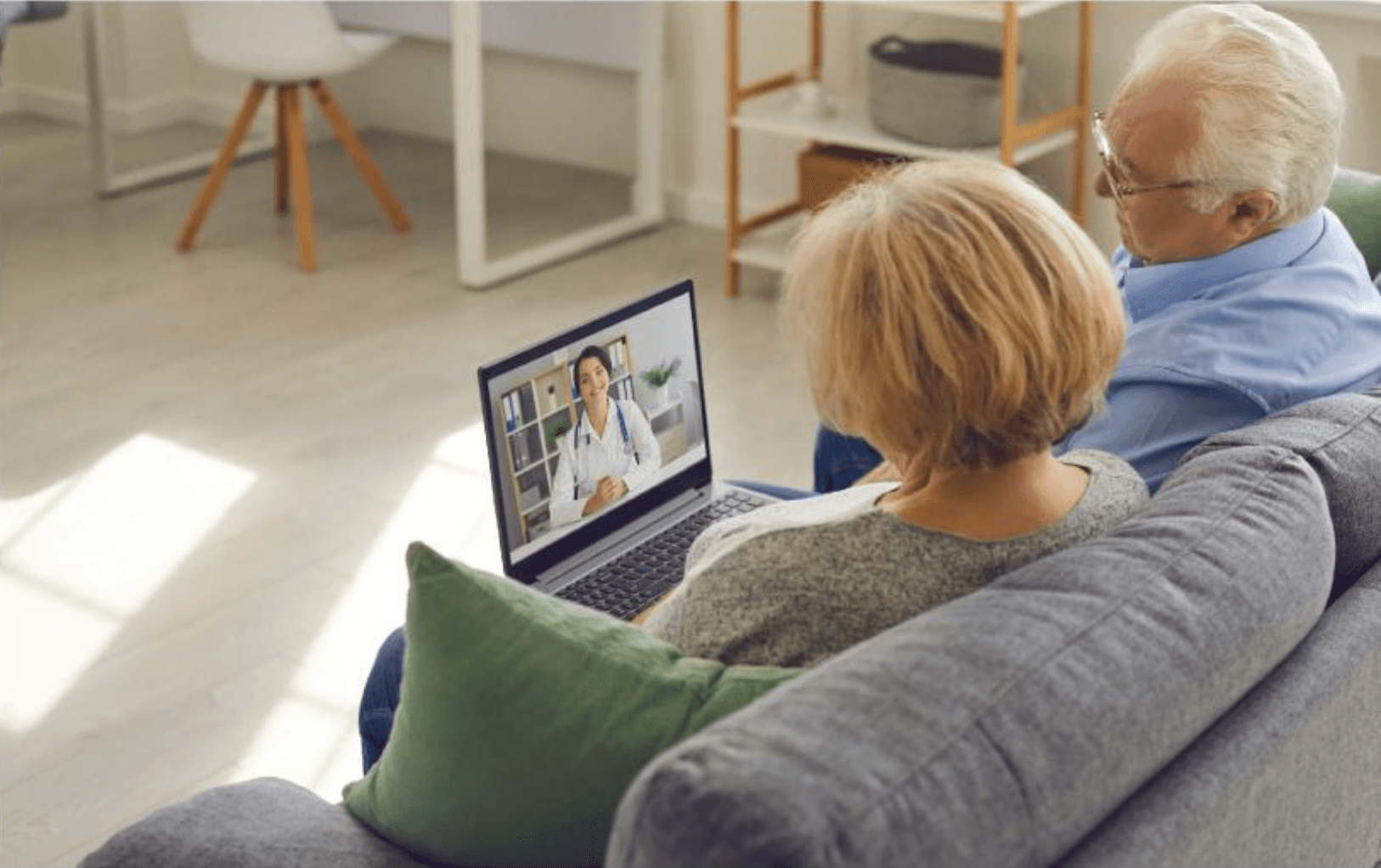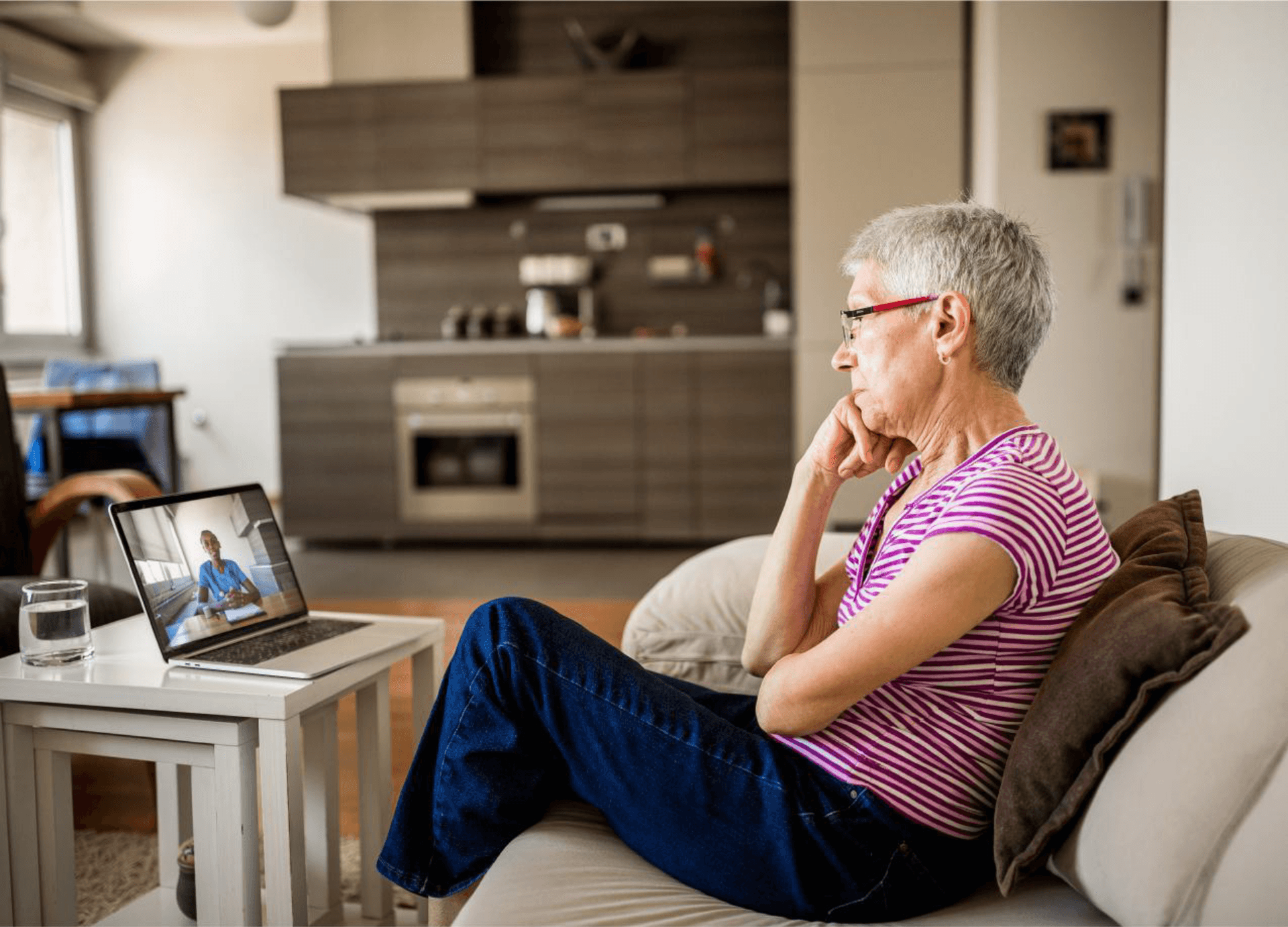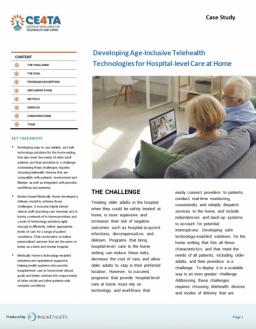KEY TAKEAWAYS
Developing easy to use, reliable, and safe technology solutions for the home setting that also meet the needs of older adult patients and their providers is a challenge. Addressing these challenges requires choosing telehealth devices that are compatible with patients’ environment and lifestyle as well as integrated with provider workflows and systems.
Boston-based Medically Home developed a delivery model to address those challenges. It includes highly trained clinical staff providing care remotely and in home, a network of in-home providers, and a suite of technology solutions agile enough to efficiently deliver appropriate levels of care for a range of patient conditions. Their model aims to deliver personalized services that are the same or better as a brick-and-mortar hospital.
Medically Home’s technology-enabled solutions and operational support is helping health systems who provide hospital-level care at home meet clinical goals and better address the unique needs of older adults and other patients with complex conditions.

THE CHALLENGE
Treating older adults in the hospital when they could be safely treated at home, is more expensive and increases their risk of negative outcomes such as hospital-acquired infections, decompensation, and delirium. Programs that bring hospital-level care to the home setting can reduce these risks, decrease the cost of care, and allow older adults to stay in their preferred location. However, to succeed, programs that provide hospital-level care at home must rely on technology and workflows that easily connect providers to patients, conduct real-time monitoring, consistently and reliably dispatch services to the home, and include redundancies and back-up systems to account for potential interruptions. Developing safe technology-enabled solutions for the home setting that hits all these characteristics and that meet the needs of all patients, including older adults, and their providers is a challenge. To deploy it in a scalable way is an even greater challenge. Addressing these challenges requires choosing telehealth devices and modes of delivery that are compatible with patients’ environment and lifestyle and integrated with provider workflows and systems. Boston-based Medically Home developed a healthcare delivery model that includes a suite of technology solutions, clinical protocols, and operational workflows agile enough to efficiently deliver appropriate levels of care for a range of patient conditions. It is also easy to use for patients and providers of all ages and abilities.
THE GOAL
Medically Home’s goal was to create a scalable, technology-enabled care delivery model for its health systems to deliver hospital-level care at home that improve outcomes, operational workflows, and overall care. Their model aims to deliver personalized services that are the same or better as a brick-and-mortar hospital.
PROGRAM DESCRIPTION
Medically Home provides not only the technology, but also operational support, reimbursement models, clinical and operational protocols, and tools to safely care for patients of all ages with serious, complex, or high-risk illness at home. The company partners with healthcare delivery organizations to assist with efficiently building and running programs. The first pilot of the model was conducted in 2015 in conjunction with Advocate Health Care in Chicago, followed by a beta site in 2016. The first patient was admitted in 2017.
The current suite of in-home devices includes the following: a tablet, the centerpiece of the system that is used for such things as scheduling and initiating/ receiving video calls; a phone, providing direct two-way communication between the patient and the healthcare provider; a battery pack for back-up power supply; a bracelet to connect the patient with the Personal Emergency Response System, to dispatch services if needed; Bluetooth-enabled scale and biometric monitoring devices, to provide near real time data; and Cradlepoint, which provides backup Internet connectivity and is equipped with chips for the two dominant cellular carriers in the area.
Medically Home promotes integration and coordination of care by facilitating bi-directional communication between the care team, patient, and in-home service providers. Integration with electronic health records through the program’s logistics software, Cesia, streamlines this process and includes the use of Bluetooth-enabled biometric devices, such as pulse oximeters, scales, and blood pressure monitoring. A dedicated department comprising engineers, product specialists, and technology experts is integrated with clinical teams to develop, research, implement and support all technologies and maximize effectiveness.
The telehealth program offers three visit types that expand the range of conditions that can be evaluated and treated virtually: on-demand visits, scheduled visits, and e-visits. The program primarily leverages on-demand and scheduled services with the latter making up the majority of the telehealth visits type.
IMPLEMENTATION
When contacted by a healthcare system to launch a program, Medically Home first conducts a market analysis and needs assessment to evaluate patient volume and availability of resources for in-home visits. Medically Home contracts with and manages all in-home service providers, bringing in its own resources as needed to fill any gaps. The team also actively engages stakeholders to ensure that diverse perspectives are considered. A six-month implementation phase follows the initial market and needs assessment. The workflows and processes are customized to each healthcare system and back- end systems, such as revenue cycle billing and electronic medical record (EMR), are integrated.
The process culminates in a one-month training and simulation period. The entire patients’ experience is recreated, from admission to discharge. Communication and monitoring systems are tested, and all other aspects of the program, such as in-home clinician visits and meal deliveries, are replicated. Provider clinicians and staff receive training on equipment, new workflows and processes during the training and simulation period. Through experience and as the acuity of patients increased, Medically Home learned they must continue to simplify their operations and interfaces. They have worked to significantly enhance their training (for both the command center and clinical teams), workflows, and technology over the years to better address the unique needs of older and more complex patients.
Once the program is live and a patient is “admitted” into the home hospital service, there are several logistical elements that need to be planned. These elements can include the delivery of meals, medications, and medical equipment, as well as scheduling the initial in-home clinician visit—when the telehealth technology is installed. Ongoing care is then provided virtually: nursing visits take place four times per day for assessments and to witness medication administration, and physician and case management visits occur once daily. Additional visits are added as needed based on the patient’s condition. Medically home manages logistics and administration of the entire home hospital stay.
METRICS
Medically Home tracks key performance indicators (KPIs) through the EMR and Cesia. KPIs include traditional hospital metrics with some specific to home-based hospital care, as well as patient and provider satisfaction, which rate the ease of use of the technology.
To date, 25,000 patients, across 17 states, have been admitted to a Medically Home supported program. The average age is 68 for males and 69 for females. Since January 2021, more than 688,000 video calls have been completed, with an average call volume of 16,242 per month. The average call length is 10 minutes and 23 seconds for video calls, and 67 seconds for audio-only calls. Video calls account for 68% of total calls with patients. The telehealth platform was designed to achieve a quick response time. The average response time when patients utilize the tablet’s “Call My Care Team” button is approximately 18 seconds.
The model has reduced readmissions by 41% between quarters 1 and 3 of 2023, with a 30-day all-cause readmission rate of 8.1%. Additionally, patient satisfaction is a crucial indicator of success for Medically Home. Ninety-five percent of patients said they would recommend the program to others.
HURDLES
Early in its development, Medically Home recognized a lack of technologies designed to meet the unique needs and challenges of older adults, prompting the company to internally develop them. The team uses continuous stakeholder feedback and observational data to improve the devices included in the in-home installation so patients would feel comfortable using the technologies. Designing the tablet with a patient-centered approach was important due to its multifunctional use, including virtual visits with nurses and physicians as well as displaying a simplified schedule for a particular day’s activities. The team of engineers worked with clinicians and technology experts to create tablets that use large fonts and colors that are most favorable to patients with visual impairment. Large touchpoint targets were included to easily facilitate performing tasks, such as calling the care team. The “Call My Care Team” button located on the home screen quickly connects the patient to someone on their care team with a touch of one button. Patients can also choose to interact with the tablet or merely have it display the schedule. Changes like these have led to an uptick in tablet use, with 100% of patients participating in video visits.
The phone provided by Medically Home followed a similar improvement process. The original phone required dialing when a patient wanted immediate access to his or her assigned nurse. Through stakeholder feedback, Medically Home learned, that patients did not like dialing the phone because the buttons were too small and the numbers were not easily readable, so it took too much time to use. The new phone provides a direct connection to the command center — no dialing is needed — and the call is automatically routed to the patient’s assigned nurse.
Medically Home also had to find a way to simplify the technology installation process when a patient was “admitted” to the program. Initially, technologists were deployed to patient homes and were responsible for the setup. Patient feedback, however, revealed that having both the technologist and clinician in the home was“ overwhelming” and “too busy.” To overcome this challenge, a training program was developed to teach the clinician who made the initial admission visit — in most cases a paramedic — how to set up the technology and train patients on the devices. This created greater efficiency and less disruption for the patient.
There were non-technological issues to overcome as well. For example, during the initial visit to the home, the clinician works with the patient to understand where time is spent throughout the day to ensure all devices have seamless connectivity and accessibility in all physical locations and that device connections do not pose fall risks. Additionally, the check-in/check-out process used by service providers, such as phlebotomists, nurses, and x-ray technicians, was also improved. Initially, it was conducted over the phone with registered nurses filling out forms, which were time- consuming. To address this, a tablet-based check-in and check-out system was introduced, reducing the work for nurses, and increasing overall process efficiency. The tablet-based process also proved to be more reliable, improving overall patient experience and streamlining care delivery and communication.
CONSIDERATIONS
Medically Home is a member of the Center of Excellence for Telehealth and Aging and is signatory of the Pledge of Support for Age-Inclusive Telehealth. The company’s program illuminates the importance of thoughtfully designing solutions that address key principles of telehealth and aging:
Equitable and Accessible: All people should have equal access to the same level of high-quality care regardless of age, ability, socio-economic status or health and technology literacy.
Person-Centered: Older adults should be at the center of decision-making — accounting for their care preferences, goals, wishes, abilities, support system and conditions.
Integrated and Coordinated: Systems should facilitate access to the information and support necessary to provide quality care to older adults, including communication between and within systems and stakeholders.
To create a business case and path for scalability of similar initiatives, continuous evaluation of key indicators — such as patient outcomes, particularly re-admission rates; cost effectiveness; and patient safety — will be important to communicate the program’s impact on patients’ overall health. Additionally, provider and patient engagement along with efficiency and satisfaction should be used to identify areas needing enhancement.
TEAM
To coordinate all the components of launching a new program, implementation teams are established at both the healthcare provider and Medically Home.
Table 1. Healthcare Provider Implementation Team

Table 2. Medically Home Implementation Support


For more information please visit:
About The Center of Excellence for Telehealth and Aging
West Health Institute (WHI), the University of Virginia (UVA) Department of Geriatrics, and the Mid-Atlantic Telehealth Resource Center (MATRC), partnered to create the Center of Excellence for Telehealth and Aging (CE4TA). CE4TA was established to advance the adoption of age-inclusive telehealth. It is a unique platform to foster a national discussion and movement to advance age-inclusive telehealth for older adults.

